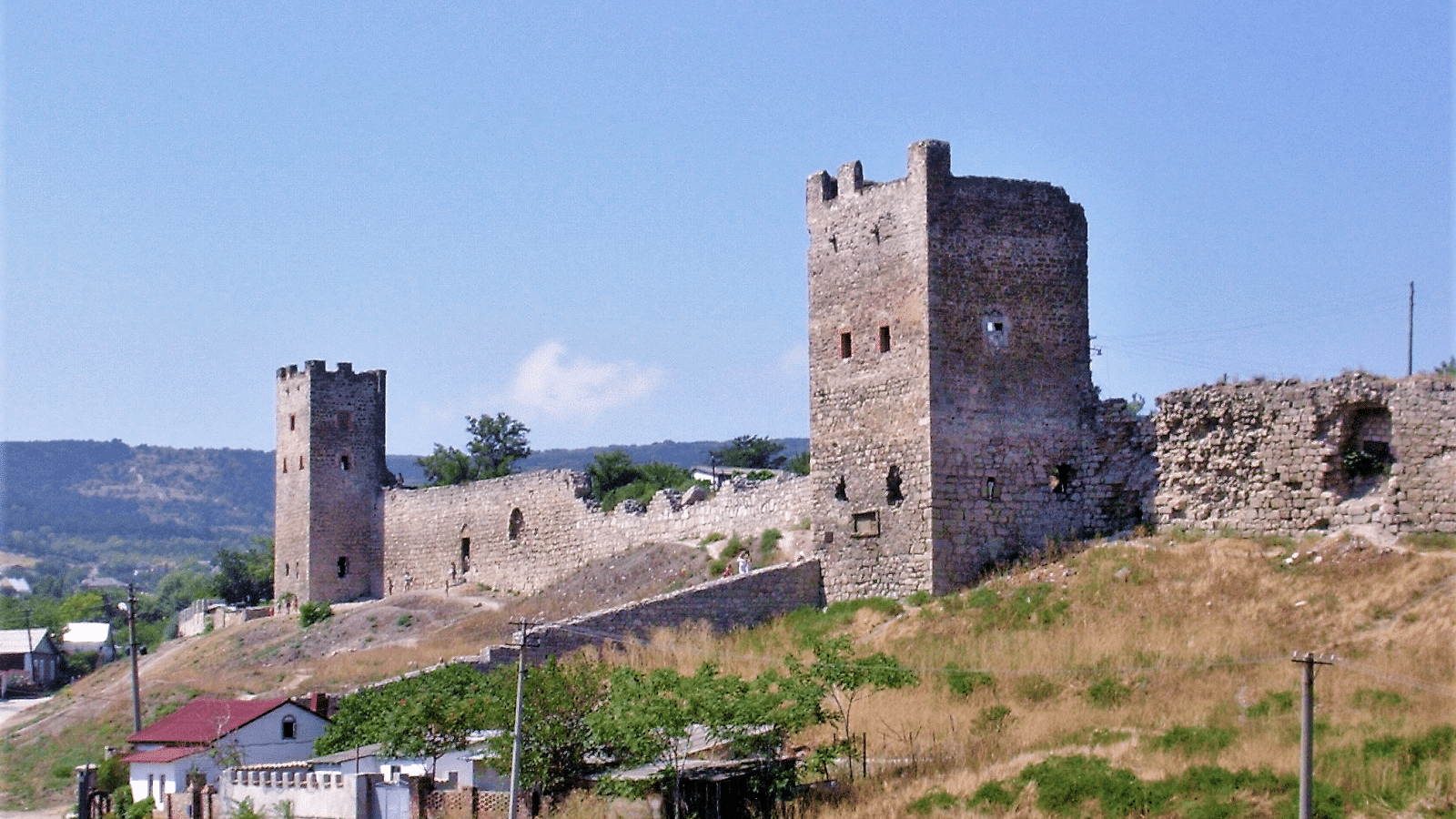Amid false Russian allegations of US “biolabs” in Ukraine, it’s worth asking: What is a bioweapon?
By Matt Field | March 25, 2022
 The former Stepnogorsk biological weapons complex in Kazakhstan. (US Department of Defense)
The former Stepnogorsk biological weapons complex in Kazakhstan. (US Department of Defense)
Earlier this month, the Russian ambassador to the United Nations all but accused the United States and Ukraine of having biological weapons. While governments around the world have signed an international treaty banning germ warfare, Russia, Vassily Nebenzia said, had “grounds to think that those hopes did not come true completely.” According to the ambassador, the Russian military had found proof that US-funded “biolabs” in Ukraine were engaged in nefarious research and were enhancing dangerous pathogens.
Experts say the documents that the Russian military allegedly acquired show that labs in Ukraine were working on public health research and aren’t evidence of a weapons program. Some of the Russian claims, at least, come from publicly available sources. At the heart of the allegations are dozens of labs in Ukraine. They are not a secret; they’re run by Ukrainian officials and partner with the US government on health research programs, for instance, surveys on natural exposure to endemic pathogens like hantavirus. These aren’t biological weapons laboratories, but the allegations raise important questions. Just what are bioweapons, anyway? How have they been used and developed throughout the years? And how can real bioweapons facilities be identified?
What is a biological weapon? George Mason University Professor Greg Koblentz, the director of the school’s biodefense graduate program, said the bacterium that causes anthrax infection has been the most commonly studied biological agent in modern biowarfare programs. That’s because Bacillus anthracis forms a spore that can be aerosolized and spread through the air, the main way to deliver a large-scale biological attack. “This is a very strenuous experience for the pathogen,” Koblentz said. “They don’t like being blown up. They don’t like UV radiation. They don’t like being suspended in air. This process will kill most of the bacteria or viruses in a biological weapon once it’s being disseminated. Anthrax spores provide that ability for them to survive that process much better than other pathogens.” With a fatality rate of 80 percent, inhaled anthrax bacteria can be a deadly weapon.
Other diseases, including the bacterial illness tularemia, have also been studied, but, Koblentz said, weapons programs have shied away from diseases like influenza that spread easily. While the Soviet Union did weaponize smallpox and plague, two contagious diseases, the US program tended to “shy away from” these agents, he said.
“You wouldn’t purposefully develop a biological weapon that is highly contagious that could cause a pandemic because that will affect your country along with everyone else,” Koblentz said.

What is the history of biological warfare? By the 1300s, warring armies in Europe had arrived at the idea of using dead animals and people, including plague victims, as weapons. According to one historical account, a Mongol army in 1346 loaded plague victims on catapults and “hurled” them into Caffa, a fortified Genoese trading post in present-day Ukraine. In 1650, Kazimierz Siemienowicz, a Polish general, reportedly laced bullets with saliva from rabid dogs. And colonial British forces in the United States gave smallpox infested blankets to Native Americans on at least one occasion. But the best example of modern biowarfare, Koblentz said, comes from the Japanese invasion and occupation of China.
Japan’s infamous Unit 731 conducted grotesque experiments on prisoners to assess the effects of biological agents like the bacteria that causes cholera, including dissections on living, unanesthetized people. The unit allegedly experimented on at least 3,000 prisoners of war; an estimated 1,000 died, according to a 1997 report by the US Surgeon General.
But far from limiting its work to lab settings, the Japanese military also tested weapons on the public in Chinese cities. Planes would fly over communities and drop plague infested flees, attacks that were followed by reports of outbreaks. “What’s not well known is that they actually integrated their use of biological weapons with their conventional military operations in China,” Koblentz said.
Despite the horrors committed by Unit 731, several of its officials were given immunity from war crimes prosecution; the United States, which by then had its own offensive biological weapons program, sought to understand what the Japanese had learned.
Which countries have had biological weapons programs? According to a 2008 tabulation by the James Martin Center for Nonproliferation Studies, more than 20 countries have or have had a biological weapons program.
Of those programs, the former Soviet Union once maintained the world’s most extensive. While the country had been developing bioweapons since the 1920s, the Soviet government secretly expanded that effort after signing the 1972 Biological Weapons Convention. The Soviet program intended to capitalize on advances in genetic engineering to produce pathogens that were more suitable for weaponization than naturally occurring strains, and tens of thousands of scientists and others worked on the illicit effort. They conducted research to make hybrid pathogens with genetic material from more than one virus; pathogens that could elude diagnostic tests; and pathogens made up of both bacteria and viruses. The Soviets had the ability to produce massive amounts of anthrax agent and other pathogens, according to a 2002 Congressional Research Service report.
The United States also had a formidable weapons program. The military had a research and development lab at Ft. Detrick in Maryland, an open-air test site in Utah, and a production plant in Arkansas which produced biological agents and filled them into delivery devices, including spray tanks, bombs, and bomblets. According to a 2009 National Defense University case study, the program’s wares included lethal antipersonnel agents, incapacitating agents, and anti-crop weapons. The offensive program, however, ended in 1969, when President Richard Nixon, after an internal review, unilaterally abandoned the weapons and had the US stockpile destroyed.
That review found that pathogens take time to incubate, making them an impractical weapon during battle, and that they could mutate or establish themselves in animal species. Officials reasoned bioweapons couldn’t be used first without drawing international condemnation and, moreover, that the country had a powerful nuclear arsenal to deter an attack. The Army destroyed its supplies of the pathogens that cause anthrax, tuleremia, and other diseases between 1971 and 1972, along with tens of thousands of munitions filled with biological agents, according to the case study. The United States ratified the Biological Weapons Convention in 1975.

How have biological weapons been tested? At Ft. Detrick, military researchers used a giant steel sphere known as the Eight Ball to test aerosolized agents on military volunteers. At the Dugway Proving Ground in the Utah desert, researchers conducted open-air experimentation, where germs were spread on the wind toward soldiers who had volunteered for tests. While researchers used animals in offensive weapons tests, the purpose of human tests was murkier, Koblentz said. More than 2,000 conscientious objectors, mainly from the Seventh-Day Adventist Church, participated in the Project Whitecoat program. That effort exposed volunteers to several diseases, including tularemia, which was eventually standardized as a biological weapons agent. The experiments led to knowledge that could be used in both in offensive weapons and for defensive purposes, Koblentz said.
The military also conducted various tests in public places using agents that could simulate dangerous pathogens. For example, researchers in the 1950 exposed the San Francisco Bay-area to aerosolized Bacillus globigii and Serratia marcescens, bacteria which were thought to be benign. According to the Surgeon General’s report, however, there were subsequent reports of infections in the surrounding communities.
Bioweapons accidents in the Soviet Union led to several deaths.
In 1971, a research vessel on the Aral Sea sailed near Vozrozhdeniya Island and into a “brownish haze.” The island was an out-door Soviet bioweapons testing site, and the haze was aerosolized version of the virus that causes smallpox. An infected crew member took the virus back home and nine people fell sick in a subsequent outbreak; three including the researcher’s brother died, according to a BBC report.
One of the worst bioweapons accidents happened in 1979 when anthrax spores leaked from a plant in the city of Sverdlovsk, now called Yekaterinburg. The leak killed at least 66 people, and perhaps more. A team that included Jeanne Guillemin and Matthew Meselson, noted bioweapons experts, plotted where each of the victims had been and, based on meteorological data, placed them in a zone downwind from the weapons plant known as Compound 19. The research showed that perhaps even less than 1 gram of anthrax spores—equivalent to a quarter teaspoon of salt—could kill many people. Had the wind been blowing toward Sverdlovsk, the death toll could have been far higher.
In 1992, former Russian President Boris Yeltsin acknowledged that the Sverdlovks outbreak had been caused by military activity and ordered an end to Russia’s offensive bioweapons program that year.
How can bioweapons programs be identified? Identifying a bioweapons program is no easy task, Koblentz said. That’s because many of the pathogens and equipment that would be necessary for an offensive program also have legitimate uses: “You can’t just look at a facility and say, ‘Oh, you have a fermenter of this size, therefore, it is civilian, or therefore it is part of a bioweapons program.’” The same goes for pathogen strains, he said. Labs might have virulent anthrax in order to produce vaccines or detection systems, for example, or because they’re dealing with public health outbreaks in the area. “Just seeing something there is by no means sufficient,” Koblentz said.
But by analyzing various facts about a site, Koblentz said, a facility’s true intention can be apparent.
Near the Kazakhstani city of Stepnogorsk, a Soviet biological weapons production facility contained “towering fermenters” that could produce two tons of anthrax in a day. The Stepnogorsk plant also produced civilian products, but the purpose of the facility was clear to analysts. “There was no plausible civilian rationale for having that production capacity,” Koblentz said. “Next door to that production building there were fortified bunkers that were designed to store the ammunition that this anthrax would go into. So looking at this combination of facilities and capabilities, you could say this is a biological weapons production facility.”
Inspectors and analysts don’t have access to all facilities they suspect of being involved in biological weapons activities. The US government, for instance, has alleged that Russia still maintains an offensive biological weapons program. Even without access, Koblentz said, there are ways to assess whether a country has an offensive program. The US government, for example, has accused a military facility at Sergiev Posad of being part of the program. “The fact that this is a military facility, it’s top secret, no outsiders are allowed in, [the] lack of transparency in itself is a tell,” Koblentz said.
In contrast, Koblentz said, the recent Russian allegations of illegitimate biological research being conducted in Ukraine rely on publicly available information. “The Russians were putting up slides being used at scientific conferences. These researchers are publishing in peer reviewed journals, right?” he said. “You don’t do that if you’re trying to hide a secret bioweapons program in Ukraine.”
How are biological weapons regulated? The Biological Weapons Convention has 183 members, called states parties. By contrast, just 10 countries have not signed or ratified the treaty. The treaty doesn’t ban pathogens or the equipment like fermenters used to work with them, biosecurity expert Filippa Lentzos said at a recent event. “We’re saying, ‘You’re not allowed to use it if it’s not for peaceful purposes.’ It comes down to intent.” While the convention has helped shape norms against biological weapons, some observers point to a gap in the agreement, the lack of a “formal verification regime to monitor compliance.” As it stands, members participate in confidence-building measures, for example, by sharing reports on biological research centers and biodefense initiatives. Violating the treaty, Koblentz said, doesn’t necessarily come with a steep price. “The treaty itself doesn’t have any real penalties and given the difficulty of proving in an unclassified way that a country is in violation—it’s challenging,” he said. “That’s been a major weakness in the whole bioweapons non-proliferation regime from the beginning.”
Part of why the Soviet Union proceeded to expand its bioweapons program after joining the Biological Weapons Convention was because officials thought that Nixon’s order to end the US offensive program was a ruse and that the United States was continuing to develop offensive capabilities. Some fear that false accusations about bioweapons programs, like the recent Russian disinformation, could erode trust and weaken the norm that prohibits the operation of clandestine programs. Well-documented cases of countries using bioweapons in war have been rare. But if a country were to reverse course, as the Sverdlovks anthrax leak suggests, the results could be catastrophic.
Together, we make the world safer.
The Bulletin elevates expert voices above the noise. But as an independent nonprofit organization, our operations depend on the support of readers like you. Help us continue to deliver quality journalism that holds leaders accountable. Your support of our work at any level is important. In return, we promise our coverage will be understandable, influential, vigilant, solution-oriented, and fair-minded. Together we can make a difference.
Keywords: Biological Weapons Convention, Russia, Ukraine, biological weapons
Topics: Disruptive Technologies
















This article is a very useful and timely primer on the threat of the weaponisation of pathogens and the difficulty of establishing intent over life science dual use research. A further crucial intertwined element that is often missing in such discussions and needs to be addressed is the threat of weaponisation of toxins (i.e. non-replicating toxic material of biological origin, and their human synthesized analogues). Previous State-level biological weapons programmes also attempted to weaponise toxins. Indeed, prior to its 1969 renunciation, the US armoury included botulinum toxin and SEB as lethal and incapacitating agents. Similarly the Soviets researched botulinum toxin… Read more »